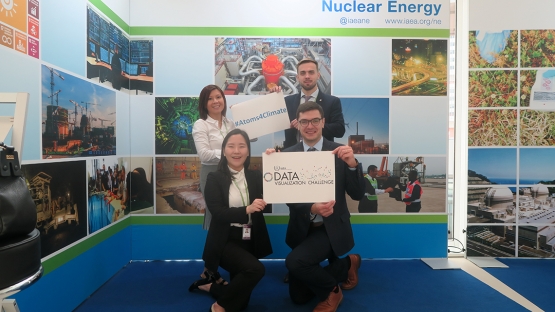Science communication is no simple task—complex concepts must be made easy to understand for audiences of varied backgrounds. To encourage innovative approaches in communicating about nuclear power’s role in combatting climate change, the IAEA recently organized a Data Visualization Challenge in which contestants were called on to present large amounts of relevant data in a simple and attractive way.
The three winning entries from Canada, Korea and Russia were invited to present their proposals at an event in Vienna alongside the recent International Conference on Climate Change and the Role of Nuclear Power, organized by the IAEA, in cooperation with the Nuclear Energy Agency of the Organisation for Economic Co-operation and Development.
“I wanted to create something vivid that would have an aesthetic appeal and provoke curiosity so that people are encouraged to explore nuclear energy,” said Harim Jung, a Korean nuclear data scientist. Jung’s wining entry was a creative visualization of the role of nuclear power in generating clean electricity, using the data from the IAEA’s Power Reactor Information System. In her work, Jung visualized nuclear power plants as planets and clean electricity generation as trees. She explained the added value of deep learning, an artificial intelligence function also known as deep neural learning that processes data including their systemic connection as would the neurones in the brain. “Deep learning for nuclear data science can help decrease uncertainty related to safety and improve public perception.”
Mary Ho, a Canadian technology program manager, was selected for her clear and informative representation of the role of nuclear power in climate change mitigation, including country-level statistics for CO2 emissions avoided, Nationally Determined Contributions and the share of nuclear in total energy generation using a variety of sources. “There is a lot of data out there, but it is very scattered – the data are available but not visible or easily accessible,” she said. “I wanted to bring different data sources together to provide insights on the topic. By creating a factual and easy to understand visual, we can make the public aware of the status of nuclear power in relation to climate change.”
Data visualizations can be an effective communication tool and can also serve other purposes, such as data driven decision-making.
“We hope that this product can be used to transfer knowledge,” said Ivan Andriushin, an engineering physicist from Russia. Andriushin and his contest partner Evgenii Varseev, a nuclear power plant personnel training specialist, received an award for their innovative, dynamic representation of international energy and economy statistics, placing nuclear power in the context of economic development, electricity consumption and CO2 emissions. “The more understandable the science is, the more people will get involved with it.”
“This is a tool that has a great potential for data driven decision making,” Varseev said. “We want to move towards predictive analytics, showing trends and analysing prospects. We are starting with communication, but this can be much more than that.”
The three winning submissions will be included in an IAEA infographics and data visualization toolkit that is being developed for training and workshops for professionals on energy economics, sustainable development and other topics in Member States, said Denis Subbotnitskiy, an IAEA Energy Data Analyst, who coordinated the Challenge.
The Data Visualization Challenge called for submissions such as interactive, dynamic or static data visuals, posters, apps and videos.
The winners received financial support to attend the International Conference on Climate Change and the Role of Nuclear Power, held in Vienna from 7 to 11 October, and were given certificates signed by Conference President Mikhail Chudakov, IAEA Deputy Director General and Head of the Department of Nuclear Energy.
The conference provided a forum for objective discussion of the scientific and technical aspects of the role of nuclear power in combating climate change. More than 500 participants from 79 countries and 18 international organizations discussed topics, including the climate mitigation challenge, implications for the power sector, environmental perspectives, and potential roles of existing, evolutionary and innovative nuclear power systems, including the integration of nuclear and renewable energy systems.




